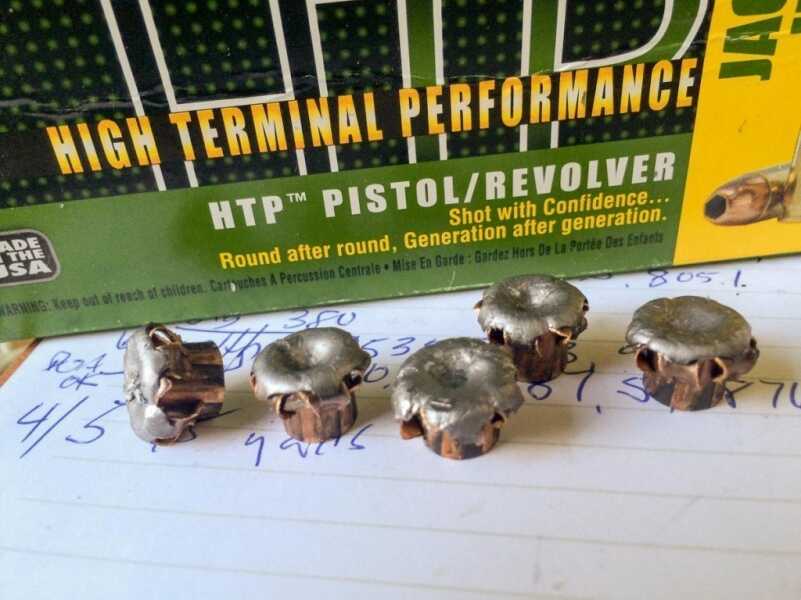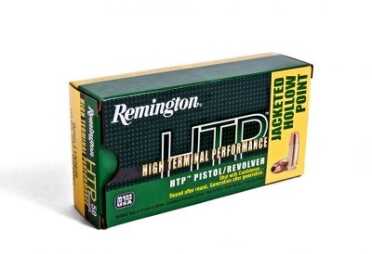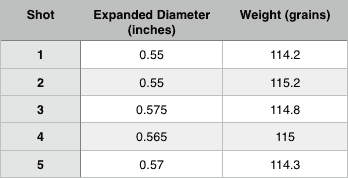
Expansion of the 115-grain 9mm rounds proved to be very good and quite consistent, as you can see here.
For more information, visit https://www.remington.com/ammunition/handgun/high-terminal-performance-htp.
Premium self-defense ammo usually costs over a buck per round.

Remington’s HTP ammo delivers good self-defense performance at a price closer to “blasting” ammo costs. Image courtesy of manufacturer.
You can look at that two ways, really. On one hand, a buck each for a product that could save your life, or that of a family member, is practically nothing. Heck, I’d have no problem spending a dollar to protect most of my family members. Just kidding, ALL of my family members. Besides, you don’t need to shoot the expensive stuff all the time. Once you figure out that it works in your carry gun reliably, you can remove it before practicing, then reload the fancy stuff when you’re done. On the other hand, laying out $25 or so per box of ammo adds up fast, especially in that new gun “do you trust it” period when you’re making sure it works with your choice of self-defense ammo.
With this in mind, we decided to run Remington’s HTP 9mm through the wringer. Going price is about $23 per box. However, that’s a box of 50 rounds, not the usual 20 for most self-defense ammo. That works out to about 45 or so cents a round, less than half the price of other self-defense ammo.
Of course, when it comes to self-defense ammo, not only does it have to fire every time, it has to meet some pretty tough performance standards. It should expand, after passing through fabric barriers. It should also penetrate to an adequate depth to do its job and stop an aggressor. Oh, and it should stay in one piece through all of that commotion and tumbling.
I acquired a few boxes and ran it through the exact same tests as the other loads we’ve been testing in GunsAmerica.com’s ammo test series. Here’s what we found.
Specs
The Remington HTP 9mm round I tested was part number RTP9MM1. It’s an 115-grain Jacketed Hollow Point design with a lead core. By the way, the HTP stands for High Terminal Performance.
Velocity and Accuracy
I did all testing with this round using a Sig Sauer P226 SAO. The pistol has proven itself exceptionally accurate with a broad variety of ammo, so it’s become my default platform to checking the performance of various 9mm loads.
For velocity measurement, I set up a Shooting Chrony Beta Master Chronograph 15 feet down range and fired 10-shot strings. I calculated overall average velocity as 1,161 feet per second. The spread from slowest to fastest rounds was only 55 feet per second, which yielded a standard deviation of 18.33. That’s pretty consistent.
For accuracy, I mounted a Bushnell Elite 2×7 handgun scope on the Sig P226 SAO to give me a perfect sight picture and rule out as much shooter sight picture error as possible. I fired some five shot groups, which all measured just a hair over two inches for all five shots, and a shade over one inch for the best three shots within the group.
Expansion and Weight Retention
 Just as with our previous tests, I fired into Clear Ballistics 4x4x16 inch gelatin blocks. I placed the four-layer FBI heavy fabric in front of the gel block. This four-layer fabric uses denim for the outer layer and cotton and insulation layers behind. It’s intended to simulate clothing with an outer jacket. Nearly any hollow point bullet will expand in picture perfect fashion when fired into bare gel, but many fail when they first have to pass through the heavy fabric.
Just as with our previous tests, I fired into Clear Ballistics 4x4x16 inch gelatin blocks. I placed the four-layer FBI heavy fabric in front of the gel block. This four-layer fabric uses denim for the outer layer and cotton and insulation layers behind. It’s intended to simulate clothing with an outer jacket. Nearly any hollow point bullet will expand in picture perfect fashion when fired into bare gel, but many fail when they first have to pass through the heavy fabric.
I fired five shots into the heavy fabric covered gel block and all five rounds expanded fully. If anything, they might have over-expanded just a hair, as the petals were bent fully backward.
After playing doctor and surgically removing the spent bullets, I measured the expanded diameters and weighed each to see how much of the jacket or inner lead core was lost during the kerfluffle.
As you can see in the photo, all the fired projectiles stayed together just as intended, with no significant weight loss. The average diameter of the expanded bullets was .562 inches or 1.58 times their original .355-inch diameter. Peachy, right?
Penetration
Penetration was also right in line with ideal performance. Among the five shots through fabric and gel, the penetration range was 14.5 inches to 16.5 inches. Two of the five barely exited the first block while the other three came pretty darn close. Excellent results, and just what you want to see.
Summing It Up
This round was a pleasant surprise in terms of performance. The bullets all expanded as they should and penetrated to an effective depth. One thing I did notice that was different than more expensive rounds was that the expanded bullets were more round when viewed from the top. Many of the premium self-defense rounds will expand into wicked star-shaped monsters that just look exceptionally painful. Just an observation, though, as these rounds did exactly what they were supposed to do, and for a lot less money.
So, if you are looking for a round that splits the difference between giving you a great self-defense round with being priced at a cost that actually allows you to practive with it, the HTP line from Remington should definitely fit the bill.
For more information, visit https://www.remington.com/ammunition/handgun/high-terminal-performance-htp.



The average “gun fight “distance is between 3 and 7 yds. Yes, some have to defend at 1 to 2 feet….but, 9 to 21 feet are
the numbers that most LE training academies use. Practicing at 25 yds is for competion shooters and those just having
fun to see if they can be accurate at that range. IF you carry for self defense, you need to be darn good at knowing how to
defend up real close and out to about 21 feet. As someone pointed out…beyond that distance a judge, or jury will be REAL
critical of your NEED to be shooting at a distance of 75 feet! I’ve attended a POST school and my son is a cop….so I’ve
learned from many LE officers over the years. I practice at 7 yds and under to make darn sure I can make that perfect
head shot and or great follow up shots to the vital organs. So, practicing at 25 yds does not mean you are a “spot on shooter”
at the “normal” defense distances. In my learned opinion.
Oh thank you for gracing us with your learned opinions, we humble peasants are so blessed to have you splashing us with you wisdom.
STFU and go back to bed you grumpy old fucker!
Say Eric, why don’t you, who from your comment obviously knows more than J. Wayne, enlighten us all with what parts of his comment are not factual and makes him a GOF as you said! Maybe your attitude is all your own reading into what you want to see!
$1 a round for premium? where do you buy ammo? There are several online ammo/supply places at .40 cents a round..
aimsurplus.com
targetsportsusa.com –my favorite if you buy a case free shipping
sgammo.com
They have Federal HST in stock for $19 a box of 50 rounds.. That ammo is arguably one of the best self defense rounds out today. I\’m not advertising for any website.. This is just where I buy it and have found them to have great prices.. Best of luck, Robert
Was just coming to the comments to post this. Not sure where the author buys ammo. I carry HST exclusively in 9mm and 45ACP, as test after test has consistently rated it one of the best if not THE best self-defense round. I just ordered again from TargetSportsUSA last week. 2 boxes (50 rounds each) of 9mm 124gr at $18.99/box + shipping. With shipping that came to $52 for 100 rounds (had I ordered more boxes shipping would have been more economical) or $0.52 per round.
Why not also test the round with a shorter(3″) barrel pistol as that would affect velocity and possibly performance. Don’t know the percentages of 3″ vs. 4″ barrel conceal carriers but think it would be worth the test.
Put a box of this ammo in .38 special thru a J frame S&W. Was accurate, but 1 round of the 50 didn’t fire. Remington quality is improving, but still an issue IMHO.
@Deanbob comment….
Self defense distance would be much shorter than 25 yds in my opinion. more like 7 feet. if you wanted 25 yds for self defense then you would have a hard time explaining to the court why you were engaging in a gun battle with hoodlums at 75 feet away…the criminals would also be running away from you so likely your shots would end up in their back, another hard thing to explain.
Federal makes a similar round which can be had for a relative bargain price too. It comes in a white box, um, sorry, a box of non-color, and is labeled Federal 115 grain HI-SHOK JHP 9BP. Whether it, or any loading, is accurate enough in the intended firearm is something that must be determined at the range. Speaking of the latter, per the first comment, I hope your testing results were from at least 25y.
You listed accuracy group size but not the distance. Crap results if shot at one yard but great if shot at 100 yards. Lol
Isn’t 25 yards a more practical distance? What are the stats on average self defense shots?